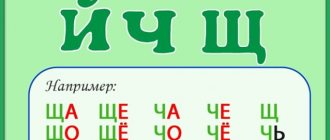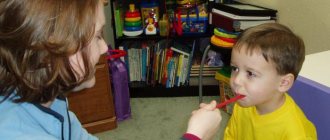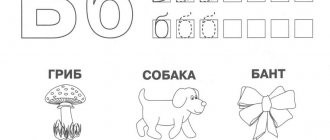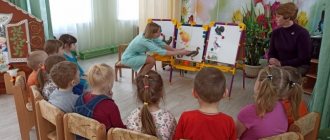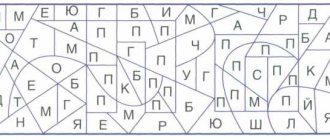What are voiced consonants?
Our speech consists of segments that are complete in meaning and intonation, which are called sentences. Each sentence is made up of individual words, and words in turn are made up of sounds. Sound is the minimal unit of speech, like words and sentences.
Sounds vary in quality. Those sounds in the formation of which only the voice participates are called vowels . These are the sounds [a], [o], [u], [e], [i], [s], which are pronounced in an open voice. The rest of our speech sounds are noisy . But they make different noises. Those sounds that are pronounced with the participation of voice and noise are voiced. When they form, air passes through the vocal cords as you exhale and causes them to tremble and vibrate. This vibration of the vocal cords can be felt by placing your hands on your throat. If you plug your ears, then when pronouncing voiced consonants, ringing in the ears occurs. When pronouncing voiceless consonants, which consist only of noise, such vibration of the vocal cords and ringing in the ears is not felt. Definition Voiced consonants are noisy speech sounds, in the formation of which noise predominates over the voice.
In the phonetics of the Russian language, there are 20 voiced sounds, which in written speech are designated by 11 letters:
- the letter “b” is the sounds [b] or [b']
- “in” - [in] or [in']
- "g" - [g] or [g']
- “d” - [d] or [d']
- “zh” - [zh]
- “z” - [z] or [z']
- "th" - [th']
- "l" - [l] or [l']
- “m” - [m] or [m']
- “n” - [n] or [n']
- “p” - [p] or [p'].
Most letters representing voiced consonants are found at the beginning of the alphabet. As you can see, many voiced consonants form pairs based on softness/hardness.
What sounds are called voiced
When pronouncing all consonants, air passes through barriers in the speech apparatus, which is why their production requires more effort than for vowel sounds. This process also affects the amount of noise, so consonants are divided into two categories: voiced and voiceless. When pronouncing dull sounds, you will produce more noise than voice; voiced ones sound bright and distinct.
Description of correct articulation
To select suitable exercises for the organs of the articulatory apparatus, you need to know their correct position when pronouncing a given sound. When a person says R, his lips take the position of the subsequent sound. The teeth are open, the tongue is raised and rests on the alveoli.
To create vibration, a strong air stream is needed. As you exhale, it hits the tip of the tongue, resulting in vibration. The vocal cords are working, the sound is loud and ringing.
Soft and hard voiced consonants
All voiced consonants differ in terms of softness/hardness, except for the always hard voiced consonant [zh] and the always soft (palatal) sound [th'].
The pronunciation of soft and hard consonants differs in the position of the tongue. When forming a soft consonant, the middle back of the tongue arches towards the speaker's palate.
The softness and hardness of voiced consonants depends on their phonetic position in the word. If after them there are vowels [a], [o], [u], [e], [s], then the consonants are pronounced firmly.
- bun [bu lka]
- gate [gate]
- hum [g u l]
- gift [d a r]
- z a r i [za r'a].
If after the consonants the letters “e”, “e”, “i”, “yu”, “ya”, “b” are written, then when pronouncing words, the voiced consonants sound soft:
- tag [b' and r k a]
- dove [g o l u b ']
- evening [v' e h' and r]
- hero [g' and r o y']
- woodpecker [d' a t' and l]
- winter [z' and m a]
The listed voiced consonants have paired voiceless consonants. Voiceless consonants form a pair with similar voiced consonants. Only in their education there is almost no voice, and noise predominates.
Staging exercises
A child of 5 years old learns almost all sounds, but if difficulties arise in pronouncing some of them or the child does not pronounce them at all, then the help of a specialist (speech therapist) will be required.
The performance must begin with charging, the so-called warming up of the articulatory apparatus. The following exercises are effective:
- "Paint brush." The child should form his lips into a smile (smile) and open his mouth slightly. After this, tell him to stroke the roof of his mouth with his tongue, starting from the upper row of teeth and moving as deep as possible towards the throat. 10-12 strokes.
- "Pendulum". The baby smiles and opens his mouth, after which he sticks out his tongue and places it first in one direction and then in the other - from the left corner of his mouth to the right (pendulum movement). 10-20 repetitions.
- "Harmonic". The child smiles and opens his mouth as wide as possible, after which he presses his tongue to the upper palate, as if he wants to pronounce a long and soft “n” sound. The mouth needs to be opened wider and then closed without changing the position of the tongue. 15-20 repetitions.
- “Brushing our teeth.” The baby smiles and opens his mouth, after which he moves the tip of his tongue left and right along the inner surface of the upper teeth, as if sweeping them. 10-15 repetitions. After this, the child, in turn, rests the tip of the tongue on each tooth from the inside (check if they remain in place).
- "Mosquito". Invite your child to open his mouth, stick the tip of his tongue behind his front teeth and say “z-z-z” (as if a mosquito is ringing). Then put your tongue in your mouth, rest it on the upper palate at the base of the teeth and say “z-z-z” again.
Such exercises ensure the development of the articulatory apparatus, help strengthen muscles and stretch the frenulum. But in order to practice the correct pronunciation of [p], it is necessary to perform special staging exercises. Ideally, classes are held daily in the morning. As a rule, in kindergarten, teachers (or speech therapists) work with children. At home, parents should take care of the baby’s articulation.
It will not be possible to teach a child to speak [r] correctly in 1 day, especially if this sound is guttural (uvular or “French r”), in this case it is advisable to seek help from a speech therapist.
There are more than ten ways to put [r]. One of the most effective speech therapy exercises for the sound [r], which allows you to teach a child to speak r on their own at home, is “Motor”. Staging is done from a drawn-out [d] using a finger or pacifier. The second method is preferable: it is more convenient and safer, a rubber or latex nipple will certainly not cause pain.
Advice It is better to perform the exercise while lying on your back, since in this case all the muscles are relaxed and when you raise the tongue towards the sky, it is easier to feel.
The sound [r] is a vibration; in order to pronounce it correctly, it is important to position the tongue correctly: it should be raised to the sky. It is necessary to take into account that its tip must rest on the alveoli located behind the incisors in the upper dentition, and the areas on the sides must touch the chewing teeth on the upper jaw. The front of the tongue should curve slightly. When an air stream passes through the entire reed, it causes its tip to vibrate - this is how the sound [p] is formed.
The baby must put his tongue in the correct position described above and open his mouth wide. Place a pacifier on your index finger and, as you exhale, when the child says “d-d-d,” move this finger along the tongue (its inner surface). The baby will automatically begin to say [rrr], as the finger will create the desired vibration.
What to pay attention to when doing it at home:
- The baby’s tongue should fit as closely as possible to the alveoli;
- you need to achieve the correct position of the lips;
- the tongue should not dangle from side to side, it must be firmly fixed;
- you need to exhale with all your might.
Articulatory gymnastics and sound production exercises will only be effective if done regularly.
Paired voiced
There are 20 voiced sounds in the Russian language, and they are designated by 11 letters. In turn, they are divided into paired and unpaired. Paired voiced ones are:
- [b] - boot [bat'inak], beet [bur'ak], Pinocchio [burat'ina];
- [b'] - to love [l'ub'it'], thrifty [b'ir'izhl'ivy'], advertisement [ab'y'ivl'en'iy'e];
- [v] - driver [vad'it'il'], lie [vrat'], beer [p'iva];
- [v'] - wreath [v'inok], see [uv'id'it'], deja vu [d'izhav'u];
- [g] - race [race], deafening [audushyt'il'nyy'], warm [sagr'et'];
- [g'] - coat of arms [g'erp], garland [g'irl'an'da], hero [g'erai'];
- [d] - long [dl'in:y'], wait [padazdat'], soul [soul];
- [d'] - duchess [d'ushes], village [d'ir'evn'a], lonely [ad'inok'iy'];
- [z] - gold [zolata], St. John's wort [z'irobay'], belly [pusa];
- [z'] - strawberry [z'iml'in'ika], earth [oz'im'], winter [z'ima];
- [zh] - leather [leather'], acorn [zholut'], rozhon [razhon].
These consonants are called paired because there are dull sounds that sound similar to them - only with less voice and more noise. These are the sounds [p], [p'], [f], [f'], [k], [k'], [t], [t'], [s], [s'], [sh] . Try to pronounce the sound from the previous list and this list alternately and you will immediately understand what we are talking about.
Unpaired voiced consonants
In the Russian language, in addition to the paired consonants considered, there are unpaired voiced consonants, which are pronounced with more voice than noise. They are called the term "sonorous", which goes back to the Greek word sonorus, which means "sonorous". As is clear from their name, sonorant consonants, by their nature, do not have a voiced/voiced pair. This group of consonants consists of 9 sounds, designated in written speech by letters:
- the letter "th" is the sound [th']
- the letter “l” is the sounds [l] or [l']
- the letter "m" is [m] or [m']
- the letter "n" is [n] or [n']
- the letter "p" is [p] or [p'].
Sonorant sounds, except for [th'], form pairs with each other based on hardness/softness.
Let's observe:
- weasel [l] - lyre [l']
- milk [m] - broom [m']
- mink [n] - seal [n']
- lynx [r] - duckweed [r'].
They do not change their sound quality and do not depend on the phonetic position in the word. The remaining voiced consonants are influenced by voiceless consonants. Their quality varies depending on their location in the word. Let us consider these phonetic processes in more detail.
Unpaired voiced
Unpaired voiced consonants do not have dull-sounding analogues. They are also called sonorous because they sound more expressive:
- [th'] - yogurt [y'ogurt], terrible [terrible'], coyote [koy'at];
- [l] - sawdust [ap'ilk'i], basket [lukushka], lily of the valley [lily of the valley];
- [l'] - elegant [el'igan'tna], lazy [l'in't'ay'], drake [s'el'iz'in'];
- [m] - silently [silent'a], smart [smart'], unique [un'ikum];
- [m'] - dream [m'ich'tat'], minister [m'in'istr], treason [iz'ena];
- [n] - knockout [knockout], necessary [necessary'], flooring [nast'il];
- [n'] - nowhere [n'egd'e], shampoo [shampoo'], fire [agon'];
- [r] - romance [raman], joyful [radasny'], defeat [parazhen'ii'e];
- [r'] - glass [r'umka], river boat [r'ich'nik], margarine [margar'in].
You can easily remember all the voiced consonants using the phrase “The lion and the toad have many friends.”
Stunning of voiced consonants
Voiced consonants, if they are at the end of a word, are in a weak phonetic position and are subject to deafening. When pronounced, they are replaced by their paired voiceless consonants:
- box [box]
- norov [noraf]
- threshold [steam]
- parade [parad]
- watchman [stohrash]
- frost [frost].
If a voiced consonant is located before a voiceless one, then similarly this is a weak phonetic position for it. The voiced consonant is affected by the voiceless consonant and becomes similar to it, that is, it changes its quality and sounds muffled. Assimilation of a voiced consonant occurs (Latin assimilatio - “likening”, “comparison”) on the basis of deafness/voice.
Let's observe:
- shelling [a p s t r' e l]
- pampering [bal a f s t v o]
- factory [za v a t s k o y']
- pointer
- tramp [b r a d ' a sh k a].
Consonant sounds do not form a phonetic syllable on their own, but only when paired with vowel sounds.
